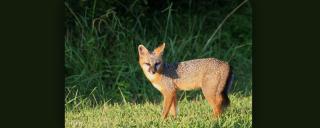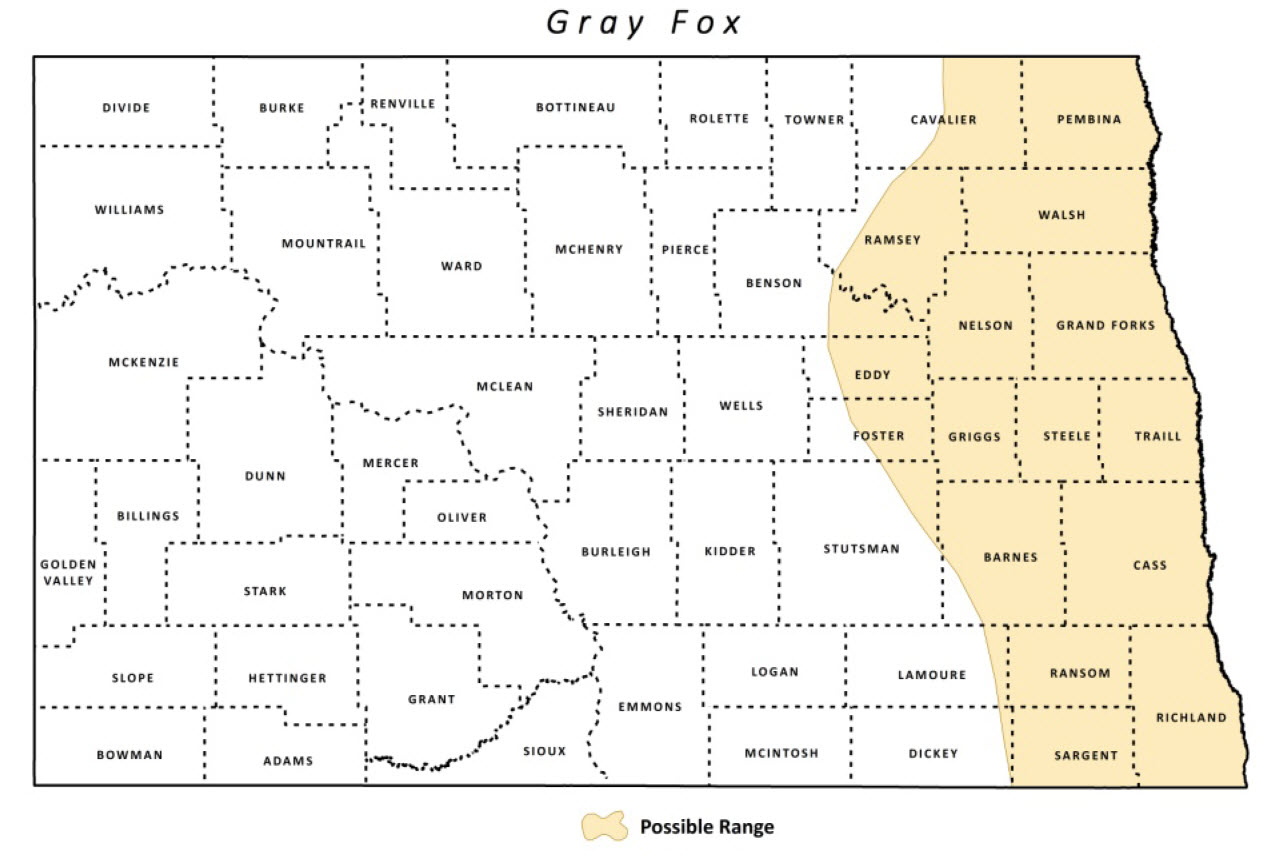
Gray Fox
| Scientific Name | Urocyon cinereoargenteus |
|---|---|
| General Description | Medium sized fox that has grizzled gray fur along its back with a light colored underside. Patches of red are found on its neck, belly and the inside of its legs. Its tail is black-tipped. It is generally smaller than the more common red fox. |
| Status | Resident |
| Abundance | Uncommon |
| Primary Habitat | This fox is found mostly in brushy or wooded habitat, generally along riparian areas. In North Dakota it is an uncommon species with most reports from the eastern side of the state. |
| Federal Status | No current federal status. Under consideration for listing under the threatened and endangered species act. |
| Reason for Designation | Due to declining abundance and distributions in the Midwest, gray foxes were petitioned for listing under the federal Endangered Species Act in 2012, but are still awaiting a full status review. Gray foxes were somewhat common in southeastern North Dakota during the 1950-1960s, but are now a rare visitor to the state. |
Locations and Conditions of Key Habitat
Preferred Habitat
Gray Fox prefer brushy/shrubby habitat often associated with forested habitats. Throughout their range they are found in agricultural landscapes and woodlots. They are often associated with riparian areas.
Key Areas and Conditions for Gray Fox in North Dakota
Uncommon in the state but records of sightings are found in most counties in the eastern 2/3rds of the state. Riparian areas of the Red, James, Sheyenne, and Missouri rivers would be potentially key areas for the Gray Fox.
Problems Which May Affect this Species
Habitat
Loss of riparian areas is a concern for Gray Fox. It uses these areas to hunt, and also dens in logs and brush piles. Conversion of grassland/shrub habitats to other land uses.
Other Natural or Manmade Factors
No other problems have been identified.
Research and Survey Efforts
Current Research or Surveys
- Northeastern State University and Dickinson State University are currently studying “Fringe Mammals” in western North Dakota. This includes Gray Fox.
Previous Research or Surveys
- Frostburg State University conducted meso-carnivore surveys within the believed range of the Eastern Spotted Skunk.
Additional Research or Surveys Needed
No additional research needs have been identified.
Management Recommendations
- Protect riparian areas where possible (i.e. easements and/or acquisition).
- Continue to use the Section 404 program to ensure affected rivers and riparian areas are mitigated to replace form and function.
- Develop and promote incentive programs to restore riparian areas.
- Continue to work with partners in promoting and distributing educational materials related to river, stream and riparian values and good stewardship.
Monitoring Plans
Gray Fox are furbearer in North Dakota. The North Dakota Game and Fish Department with use fur harvest records and reports to the rare furbearer recording system to track Gray Fox.
2005-2015 Progress
The Gray Fox was added to the Species of Conservation Priority list in the 2015 revision of the Wildlife Action Plan due to its potential listing under the Endangered Species Act. Although uncommon its range does include eastern North Dakota.

Note: A listing of works consulted when compiling the information on this page may be found in the 2015 State Wildlife Action Plan.
